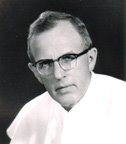The Role of the Mill Hill Missionaries at St Ann
 St Ann began as an outstation mission of St Joseph’s Church (at present St Joseph’s Cathedral) in the late 1940s. The Archdiocese of Kuching had not yet existed.
St Ann began as an outstation mission of St Joseph’s Church (at present St Joseph’s Cathedral) in the late 1940s. The Archdiocese of Kuching had not yet existed. The first pioneer to start this mission was Fr Harry Van Erp, a Mill Hill Missionary who began his work of evangelisation to villages such as Semeba, Seratau, Tijirak and Simpok. His initial efforts to these villages have borne much fruit, as they now boast hundreds of Catholic families. Fr Harry also saw to the education of poor children, who became future evangelisers of their own villagers. By then, mission sponsored mission schools were also built.
In 1963, another Mill Hill by the name of Fr Tepstra engineered the idea of building a parish house or a presbytery, based at ‘10th Mile’—a bazaar with a sprinkling of settlements—which would serve as a base for the priests to work. There was no Church built, as the structure would act mainly as a working base. A chapel was constructed within the presbytery, which met with the needs of the priests to pray and conduct small-scaled weddings. Thus, St Ann’s Mission was born.
By the 1970s, 30 outstations had been established, and by the 1980s, the number increased to 40. By the 1990s, the Catholic population around the Mission had grown so rapidly that a hall had to be constructed to cater to Sunday Masses which were celebrated once a month due to the shortage of priests. An open-air prayer hall in the style of a Bidayûh Meeting House was built. Locally known as a ‘Baruk’, it now serves as a make-shift Church to an ever-growing population.
To date, St Ann’s parish cares for 45 villages, 14 schools and more than 10 housing estates, with a population of 18,167 Catholics. An average attendance at Sunday Masses in the ‘Baruk’ clocks at approximately 800 people, squeezed in a hall which was meant to hold about half the number. Recently, the Sacrament of Confirmation was celebrated twice in the parish, with Archbishop of Kuching administering the sacrament to more than 300 candidates!
Latest Update Nov 2011 - The villages have increased to 48 and the housing estates have increased to 14

